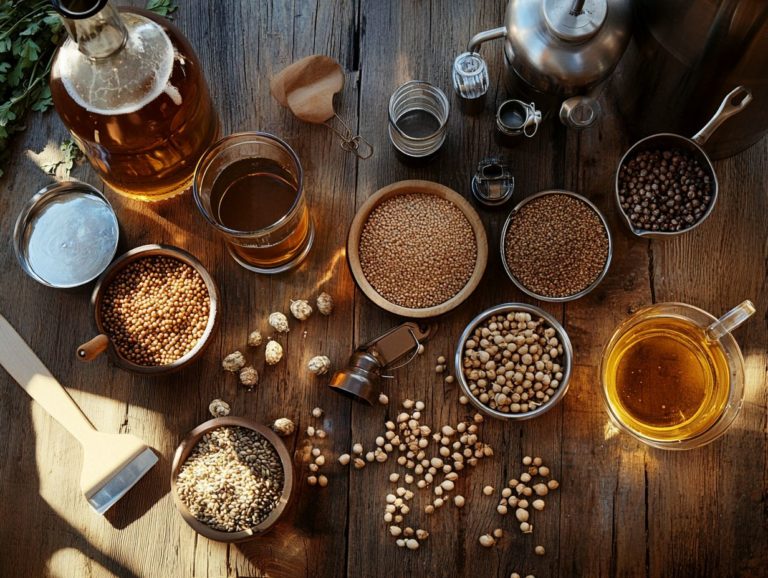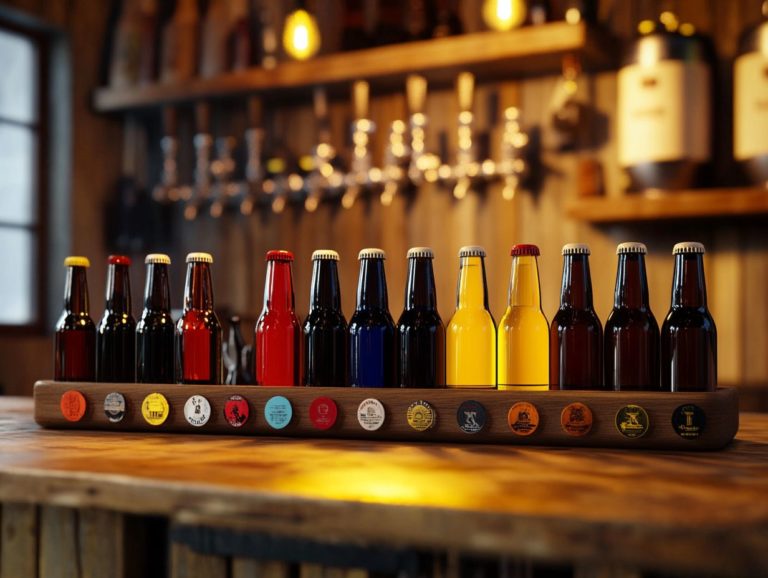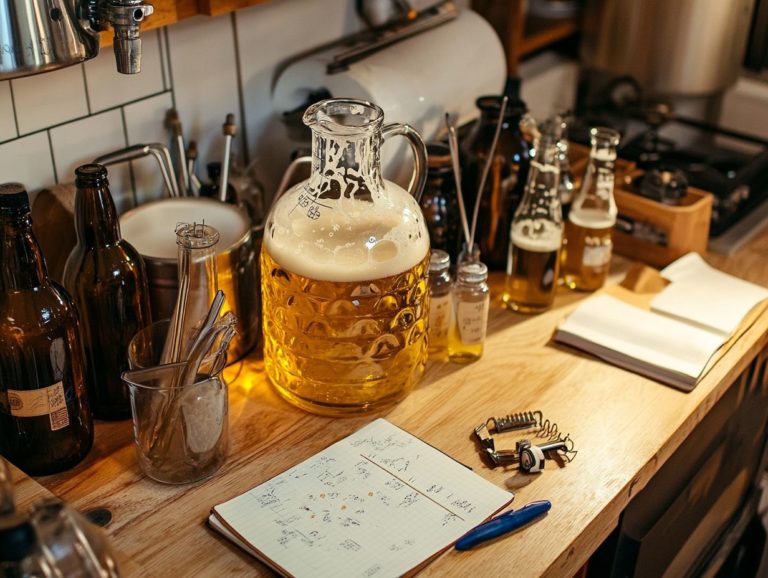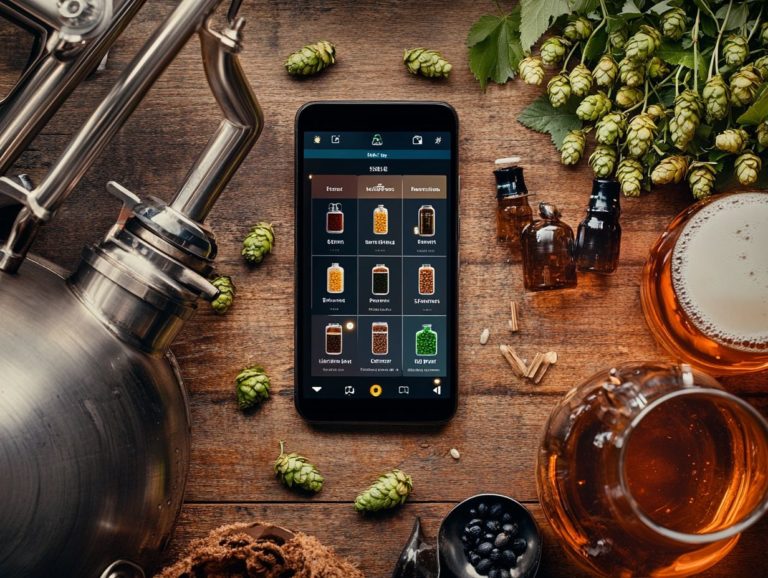What Are the Best Yeasts for Home Brewing?
Contents
- Unlocking the Magic of Home Brewing: Exploring Yeast
- Choosing the Right Yeast for Home Brewing
- What Are the Factors to Consider When Choosing Yeast for Home Brewing?
- What Are the Best Yeasts for Different Types of Beers? Exploring the Characteristics and Cultures of Yeasts
- Yeast Strains in Brewing
- Frequently Asked Questions
- What Are the Best Yeasts for Home Brewing?
- What are the characteristics of American Ale yeast?
- What are the characteristics of Belgian Ale yeast?
- What are the characteristics of German Lager yeast?
- Can I use bread yeast for home brewing?
- What are some other factors to consider when choosing a yeast for home brewing?
- Can I use different types of yeast in the same batch of beer?
Unlocking the Magic of Home Brewing: Exploring Yeast
Home brewing is a refined art that intertwines creativity and science. Yeast serves as a pivotal player in the fermentation process, much like hops, which add unique flavors and aromas to beers.
By delving into the various types of yeast and their distinct characteristics, you can elevate your brewing endeavors. Whether you re crafting a zesty IPA, a rich stout, or a traditional British ale, the right yeast makes all the difference.
This article invites you to explore the diverse yeast varieties, essential factors to consider when selecting the perfect one, and tailored recommendations for specific beer styles.
Unlock the secrets of yeast and enhance your brewing experience to new heights!
Key Takeaways:
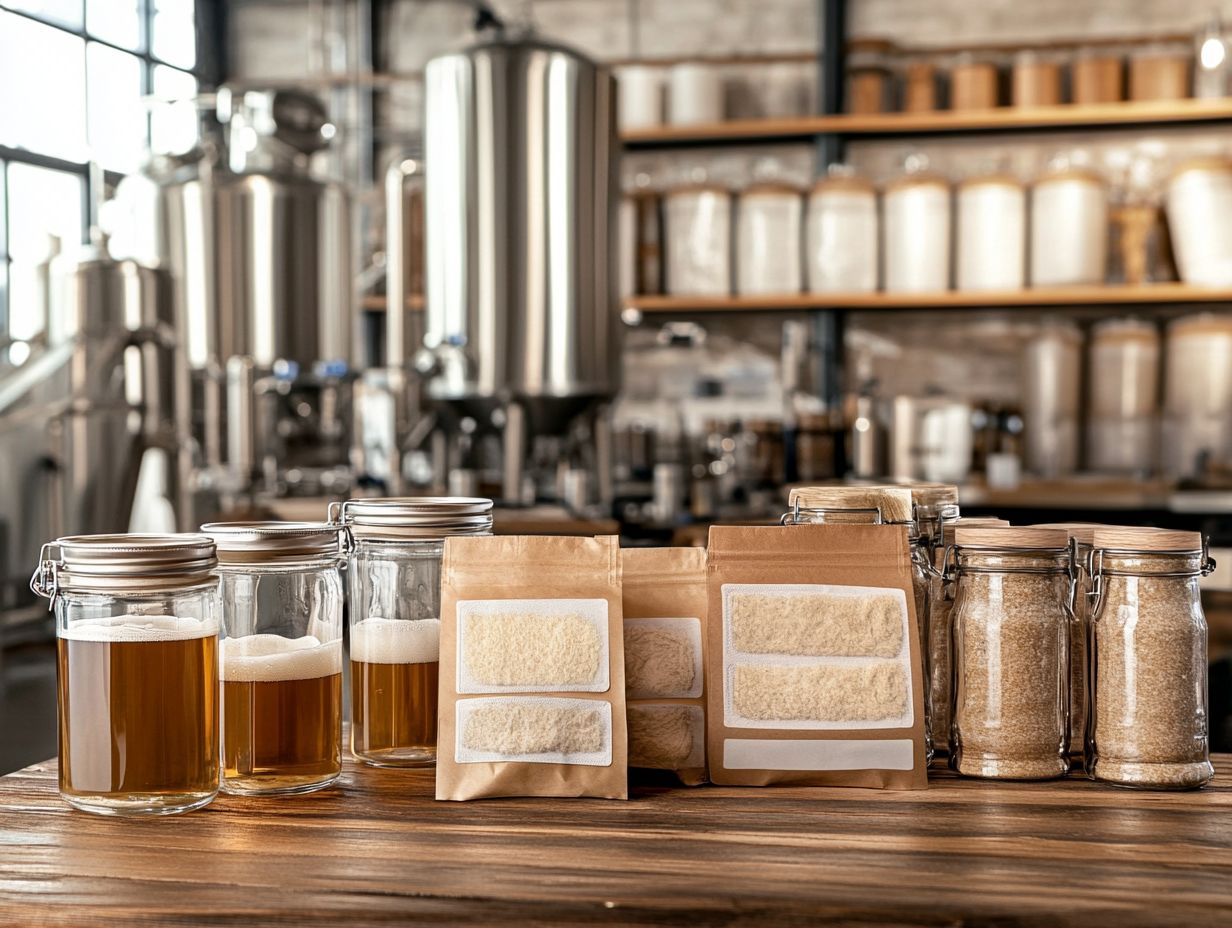
- Ale yeast is best for top-fermenting beers, while lager yeast is ideal for bottom-fermenting beers.
- Wild yeast can add unique flavors to beer but requires more time and attention during fermentation.
- Consider factors like fermentation temperature, alcohol tolerance, and flavor profile when choosing yeast for home brewing.
What Is Yeast and Its Role in Home Brewing?
Yeast, a remarkable single-celled fungus, serves a crucial function in home brewing by transforming sugars in the liquid extracted from grains into alcohol and carbon dioxide during fermentation. You’ll encounter various strains of yeast, such as Saccharomyces cerevisiae, each vital for producing a diverse array of beers, from ales to lagers, each with its distinct character and flavors.
The yeast you select can profoundly impact the brewing process and the final taste of your beer. This makes it an essential element in your quest to craft the perfect brew.
What Are the Different Types of Yeast Used for Home Brewing?
Exploring the history and culture of yeast, especially Saccharomyces cerevisiae, reveals the fascinating journey of beer brewing across different regions and traditions.
In home brewing, you can choose from a variety of distinct yeast types. Each type adds its own unique characteristics to your final creation, including those used in brewing Pilsners, Bocks, and Dortmunders.
Ale yeast, for instance, typically ferments at the top and yields clean, fruity esters that can elevate your brew. On the other hand, lager yeast settles at the bottom, imparting a crisp and refreshing profile. For those interested in unique and historical strains, Kveik yeast offers remarkable versatility in brewing.
Options such as wine yeast, champagne yeast, and wild yeast introduce layers of complexity and flavor variations, inviting you to explore and experiment with a variety of beer styles.
1. Ale Yeast
Ale yeast, with its top-fermenting prowess, thrives at higher temperatures. This allows you to explore a delightful spectrum of flavors think fruity esters and spicy phenols that are essential for crafting those distinctive American and Belgian ales.
This fascinating fermentation process typically unfolds between 60 to 75 degrees Fahrenheit, a sweet spot that encourages the yeast to showcase its full flavor potential. This directly influences the character of various ale styles, from vibrant IPAs to rich stouts, including the robust flavors found in Imperial Stouts.
If you opt for the esteemed American Ale yeast, such as Wyeast 1056, you ll find it imparts a clean malt profile with just a whisper of citrus ideal for those hop-forward IPAs you love.
If your heart leans toward the enchanting world of Belgian ales, consider the renowned Wyeast 1214. This Belgian yeast strain is celebrated for producing rich, complex flavors with delightful notes of banana and clove, perfectly suited for those enticing Belgian-style brews.
Your choice of ale yeast plays a pivotal role, shaping not just the aroma and taste, but the entire experience of the brew.
2. Lager Yeast
Lager yeast functions quite differently from ale yeast, as it ferments at lower temperatures. This results in a clean, crisp finish with minimal fruity esters. Hence, it is the perfect choice for brewing classic styles like Pilsners and M rzen.
The fermentation process usually occurs between 45 F and 55 F (7 C to 13 C). This allows lager yeast to produce fewer byproducts during fermentation.
In contrast to ale fermentation, which thrives in warmer conditions and encourages the development of bold flavors, the cooler environment of lager fermentation promotes a refined profile. This profile features subtly layered malt and hop components.
Styles such as Helles and Dunkel highlight this yeast’s unique ability to create a well-rounded body and smooth mouthfeel. This transformation turns each sip into a delightful experience. The emphasis on cleanliness in lager beers often brings forward the malt’s sweetness and the crispness of the hop bitterness, showcasing the intricate artistry of lager yeast fermentation.
3. Wine Yeast
Wine yeast is primarily known for its role in wine production, but it also offers remarkable versatility in brewing. By incorporating wine yeast, you can introduce distinctive fruity esters and flavors that elevate specific beer styles, particularly fruit beers.
This flexibility opens the door to many flavor profiles. It is an exciting option for those eager to venture beyond the confines of traditional ale and lager yeast.
When you employ wine yeast, you can explore a broad variety of fermentation outcomes. This often leads to complex aromatic characteristics that enhance your brews.
For example, when you add wine yeast to recipes featuring cherries or raspberries, it can amplify the fruit’s natural essence. This creates layers of flavor that tantalize the palate. Its remarkable ability to thrive in diverse fermentation conditions makes wine yeast an enticing choice for crafting unique hybrid beers that blend the best elements of both wine and beer traditions.
4. Champagne Yeast
Champagne yeast is celebrated for its impressive alcohol tolerance and knack for producing sparkling wines. This makes it an ideal choice for home brewers eager to craft carbonated beers or robust high-alcohol styles.
This amazing yeast flourishes in fermentation temperatures between 55 F and 75 F. It adapts seamlessly to a variety of brewing conditions. Its distinctive characteristics contribute to a clean and crisp flavor profile, essential for cultivating the refreshing qualities found in many sparkling beer styles.
If you’re a home brewer looking to elevate your creations, leveraging the capabilities of champagne yeast can help you achieve a more refined beverage. This promotes greater complexity without overshadowing the ingredients. By experimenting with this yeast, you can craft unique options that highlight fruitiness or floral notes, all while preserving the lively effervescence that sets sparkling beers and ciders apart.
5. Wild Yeast
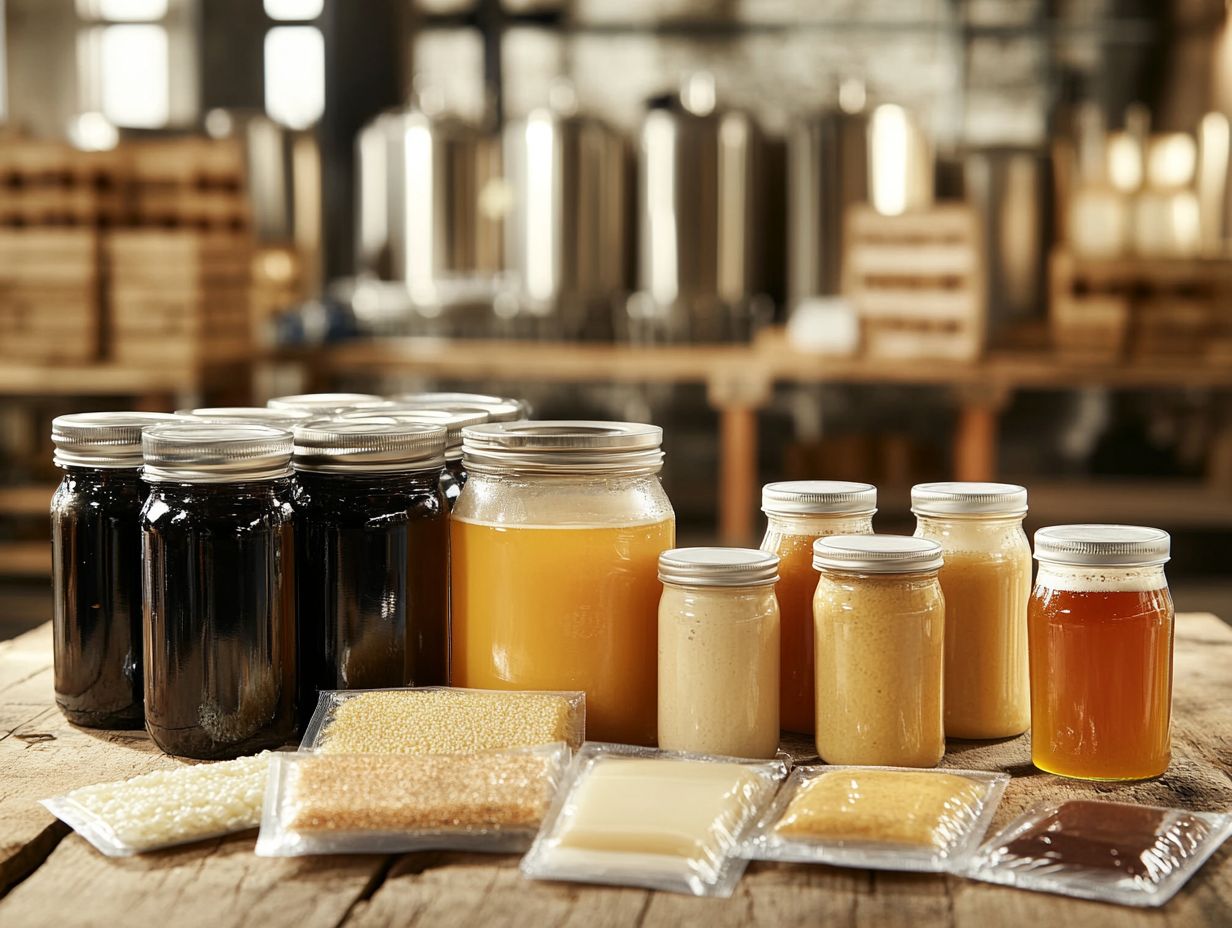
Wild yeast, especially intriguing strains like Brettanomyces, opens up a world of possibilities for you as a brewer. This allows you to infuse unique flavors and aromas into your beers. The result is the creation of complex sour and funky profiles that have become all the rage among craft beer aficionados.
This captivating and unconventional fermentation process invites a spontaneous interaction between the yeast and its environment. It captures the true essence of the local environment in every batch. As your beers mature, they evolve, developing layers of complexity that may feature delightful notes of fruit, barnyard, and earthy undertones.
Styles such as farmhouse ales and sour beers beautifully showcase the remarkable effects of wild yeast. They often deliver a charming tartness and a refreshing finish that can captivate the palate in exciting ways.
The unpredictability of wild yeast adds an element of surprise to your brewing journey. This ensures that each brew you create is a unique celebration of flavor, much like the traditional techniques used in crafting Belgian and wheat beers.
Choosing the Right Yeast for Home Brewing
What Are the Factors to Consider When Choosing Yeast for Home Brewing?
When choosing yeast for your home brewing endeavors, it’s essential to consider several critical factors that ensure successful fermentation and help achieve the desired characteristics of your beer. Pay attention to fermentation temperature, alcohol tolerance, flavor profile, attenuation (the reduction of sugar in the beer), flocculation rates, and sediment formation.
Each of these elements can significantly influence the final product. A thoughtful selection will elevate your brewing experience.
1. Fermentation Temperature
Fermentation temperature plays a pivotal role in influencing yeast activity, flavor development, and the overall success of your brewing endeavors. Each yeast strain has its own optimal temperature range.
Explore how varying temperatures can unleash amazing flavors! For instance, lower fermentation temperatures are typically favored for lagers. This results in cleaner profiles with subtle malt character and minimal fruity esters.
On the other hand, certain ale yeast strains thrive in warmer environments. They produce more esters and phenols, lending fruity and spicy notes, such as the distinctive flavors of clove and banana in Belgian styles.
However, pushing these strains beyond their ideal temperature range can lead to unwanted off-flavors, such as overly ripe banana or clove, which can detract from the intended style. Thus, mastering the art of fermentation temperature control is essential for any brewer aspiring to create consistent, high-quality beers free from undesirable byproducts.
2. Alcohol Tolerance
Alcohol tolerance refers to the maximum alcohol concentration a yeast strain can endure during fermentation. It plays a pivotal role in shaping both the style and strength of the beer you are brewing.
This tolerance is critical for brewing high-alcohol styles like Imperial Stout and Dortmunder. Different yeast strains showcase varying levels of tolerance, significantly impacting the fermentation process and the resulting flavor profiles.
For example, some yeast types flourish in high-alcohol environments, making them ideal for crafting robust styles like Imperial Stouts or Barleywines. Conversely, certain strains may struggle under these conditions, resulting in lower alcohol content and distinct characteristics.
This inherent variability provides you with the opportunity to experiment across a vast array of styles. You can adjust your yeast selection based on the desired outcome whether you’re aiming for the rich, complex flavors of high-alcohol brews or the crisp, refreshing qualities of lighter ales, lagers, and Pilsners that thrive with lower fermentation potentials.
3. Flavor Profile and Yeast Strains
The flavor profile created by yeast during fermentation is a pivotal element of brewing. Different yeast strains produce varying levels of esters and phenols, resulting in a spectrum of taste experiences in the final beer.
This complexity shines in styles like Belgian ales, where the yeast delivers delightful fruity notes, such as banana and clove, largely due to specific phenolic compounds. For IPAs, brewers typically choose yeast that amplifies citrus and tropical fruit esters, perfectly balancing the hop bitterness.
Yeast selection is crucial for M rzen and Bocks as it defines their rich and malty profiles. Selecting the right yeast strain enables you to refine the aroma and flavor characteristics of your creations.
By grasping the metabolic processes of yeast and understanding its interaction with other ingredients, you can craft a unique taste profile that resonates with beer enthusiasts. This knowledge helps mitigate off-flavors and optimize the magical transformation of wort into beer.
4. Yeast Flocculation
Flocculation is the fascinating process where yeast cells gather and settle at the bottom of your fermentation vessel. This phenomenon shapes the visual appeal of your brew and influences its mouthfeel and taste profile, while also playing a pivotal role in the clarity and sediment of your final beer, alongside enhancing overall brewing efficiency.
You ll find that different strains of yeast showcase unique flocculation characteristics. Some yeast types are highly flocculent, quickly forming a dense sediment, while others may linger suspended, creating cloudier beers. For example, British ale yeasts often display medium flocculation, balancing clarity and flavor complexity.
When brewing lagers, opting for highly flocculent yeast can lead to crisp, clear brews. In contrast, certain ales might embrace a hazier appearance that highlights their complex flavor profiles.
Ultimately, understanding yeast flocculation enables you to tailor your brewing techniques, allowing you to craft a diverse array of beer styles with the attributes you desire.
5. Attenuation
Attenuation is the measure of how effectively yeast converts sugars into alcohol and carbon dioxide during fermentation. It plays a pivotal role in determining the final gravity and dryness of your beer. Attenuation can vary from high to low, impacting the residual sweetness and overall drinkability of the beer.
The significance of this process cannot be understated. It directly shapes the overall character and flavor profile of your finished product. Different yeast strains showcase varying levels of attenuation, leading to distinct differences in mouthfeel and sweetness across various beer styles.
Consider ales, which typically employ yeast that achieves higher attenuation, resulting in a drier, more crisp finish. Some yeast strains used in wheat beers may have medium attenuation, contributing to their characteristic mouthfeel and flavor.
In contrast, certain lagers may retain more residual sugars, creating a sweeter and fuller mouthfeel that enhances their drinkability.
By understanding these dynamics, you can craft specific styles that resonate with your target audience. This ultimately weaves a rich tapestry of flavors and textures in the world of beer. Whether you’re brewing at home or commercially, mastering attenuation helps in creating consistently excellent beers.
What Are the Best Yeasts for Different Types of Beers? Exploring the Characteristics and Cultures of Yeasts
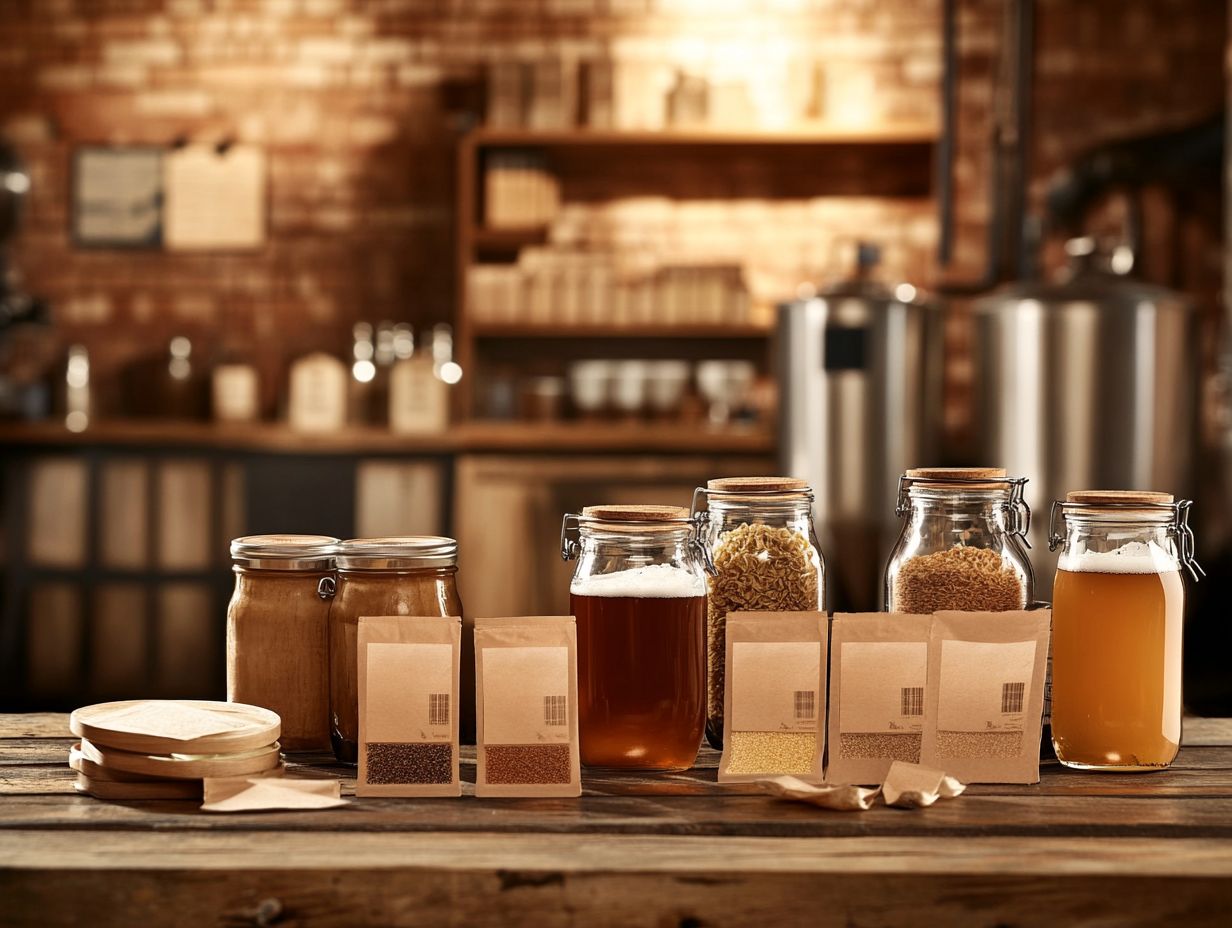
Selecting the right yeast for various beer styles is crucial for attaining the specific characteristics and flavors you desire. Each yeast strain brings its own unique qualities, making certain strains particularly well-suited for styles like:
- pale ales
- stouts
- porters
- wheat beers
- Belgian ales
- Pilsners
- Bocks
1. Best Yeasts for Pale Ales and IPAs: American Influence
When brewing your pale ales and IPAs, consider favoring yeast strains such as American Ale yeast. These strains are prized for their ability to produce clean flavors, allowing the hop characteristics to truly shine while enhancing those delightful fruity and citrus notes. The American Ale yeast strain is particularly known for its clean fermentation profile, making it ideal for these styles.
These yeast selections do more than just contribute to the overall crispness of your beer; they play a crucial role in crafting a balanced profile that harmonizes beautifully with hoppy bitterness. Take, for example, the renowned California Ale yeast strain, which is celebrated for its bright, zesty flavors. It’s a go-to choice for brewers aiming to create IPAs that are both accessible and full of flavor.
The Kveik yeast strain is also popular for its ability to ferment at high temperatures while producing clean and fruity flavors.
Notable beers like Sierra Nevada Pale Ale and Stone IPA serve as prime examples of how these yeast strains can elevate your brewing experience. They result in a captivating harmony between malt, hops, and the esters produced by the yeast. Using such yeasts ensures the production of a clean and balanced beer, showcasing the collaborative magic of yeast and ingredients.
Yeast Strains in Brewing
2. Best Yeasts for Stouts and Porters: British and Irish Influence
When you craft rich and complex stouts and porters, consider using yeast strains like English Ale yeast to elevate the dark malt flavors. This enhances the beer’s overall smoothness and depth. This particular strain flourishes at slightly warmer fermentation temperatures, allowing for the development of fruity esters that beautifully complement the chocolate and coffee notes inherent in these styles. The yeast’s attenuation level (the degree to which yeast converts sugars into alcohol) also affects whether the beer has a drier or fuller mouthfeel.
You might also find it intriguing to experiment with other yeast varieties, such as Irish Ale yeast, which is renowned for its clean and crisp profile. This strain offers a subtle dryness that accentuates the richness of the roasted malts.
Notable examples of this yeast in action can be discovered in classic brews like Guinness Draught and Founders Breakfast Stout. Here, the yeast plays a pivotal role in balancing and amplifying the intricate flavors of these beloved dark beers. These examples illustrate how yeast selection can significantly impact the flavor, mouthfeel, and overall character of the beer.
3. Best Yeasts for Wheat Beers: Celebrating Tradition and Innovation
Wheat beers, especially Hefeweizens, thrive on yeast strains that bring forth distinctive flavors like banana and clove. These elevate their refreshing and aromatic profile. These yeasts often have medium attenuation, achieving the right balance between dryness and sweetness.
These remarkable yeast strains, such as the illustrious Weihenstephan and Wyeast 3068, are celebrated for their exceptional ability to produce esters and phenols during fermentation. This infuses those cherished fruity and spicy notes into the brew. The yeast’s historical use in wheat beer brewing is a testament to its lasting impact on beer culture and flavor.
Breweries eagerly embrace these yeast characteristics to create vibrant, sessionable beers that shine in warmer weather, reflecting the magic of traditional brewing techniques combined with modern innovations.
Notable examples include traditional German Hefeweizens like Franziskaner and Schneider Weisse. These elegantly highlight the yeast’s contributions, delivering a delightful bouquet of flavors that dance across the palate. No wonder these brews have captured the hearts of both craft beer aficionados and casual drinkers alike try them today!
4. Best Yeasts for Belgian Ales: A Rich History of Craftsmanship
Belgian ales are renowned for their intricate flavor profiles, showcasing yeast strains that yield fruity esters and spicy phenols elements essential for crafting the distinctive taste of this traditional beer style. These unique yeast characteristics are pivotal in shaping the identities of various Belgian beers, influencing everything from the aroma to the finish. Belgian yeasts often produce a medium level of attenuation, balancing dryness and residual sweetness effectively.
Among the most celebrated yeast options, you’ll find various strains of Saccharomyces cerevisiae, which can evoke delightful notes of banana and clove, reminiscent of the classic Belgian witbiers. On the other hand, Brettanomyces is often utilized in more artisanal brews, introducing a wild, earthy flavor that beautifully complements the inherent sweetness of these ales. The interaction between these yeast strains and the wort results in the complex and layered character of Belgian ales.
Notable examples, such as the fruity notes found in Duvel and the complex aromas present in Chimay, vividly illustrate the captivating influence of yeast in Belgian brewing.
5. Best Yeasts for Sour Beers: Embracing Complexity and Innovation
In the world of sour beers, you ll find unique yeast strains like Brettanomyces and Lactobacillus at play, crafting complex sour flavors and enticing aromas that contribute to the rising allure of this innovative beer style. These strains set sour beers apart from traditional varieties, offering you an impressive range of taste experiences. Home brewers and commercial breweries alike appreciate the flexibility and creativity these yeasts bring to the brewing process.
Brettanomyces, often lovingly called Brett , brings a funky, earthy character to the table, capable of introducing intriguing notes that can span from leather to tropical fruits, all depending on the fermentation conditions. On the other hand, Lactobacillus adds a lactic sourness that delivers a refreshing acidity reminiscent of tart yogurt or zesty citrus. The careful management of these yeasts helps avoid unwanted off-flavors, ensuring a delightful drinking experience.
Craft brewers often blend these yeasts to strike a perfect balance of flavors, evident in beloved offerings like Russian River s Supplication and Cantillon’s Gueuze. These brews beautifully exemplify the delightful complexity that sour beers can provide, inviting you to explore their vibrant profiles.
Frequently Asked Questions
What Are the Best Yeasts for Home Brewing?
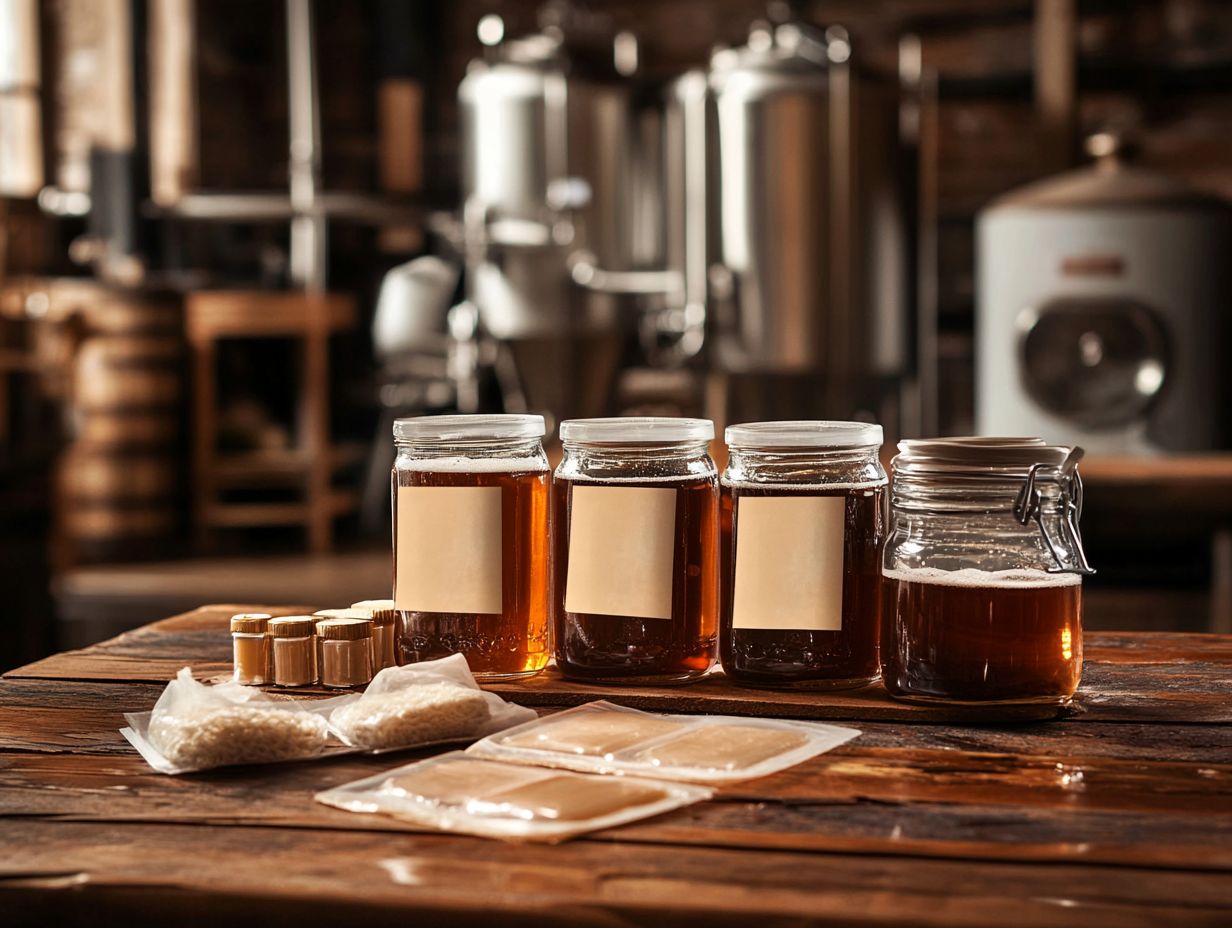
The best yeasts for home brewing depend on the type of beer you want to brew and your personal preferences. Some popular options include American Ale yeast, Belgian Ale yeast, German Lager yeast, and Kveik yeast. Additionally, dry and powdered yeast strains are available for home brewers.
What are the characteristics of American Ale yeast?
American Ale yeast, a strain of Saccharomyces cerevisiae, is known for producing clean, crisp flavors and aromas with a medium to high level of attenuation. It is commonly used in American-style ales and can handle higher gravity beers, contributing to their unique character.
What are the characteristics of Belgian Ale yeast?
Belgian Ale yeast is known for producing spicy, fruity, and complex flavors and aromas, often including esters like clove and banana. It has a high level of attenuation and is commonly used in Belgian-style beers such as Saisons, Dubbels, and even Imperial Stouts.
What are the characteristics of German Lager yeast?
German Lager yeast is known for producing clean, crisp flavors and aromas with a low level of attenuation. It is commonly used in German-style beers such as Pilsners, Bocks, M rzen, and Dortmunders. This yeast is ideal for creating a clear beer with minimal off-flavors.
Can I use bread yeast for home brewing?
No, bread yeast is not recommended for home brewing as it is not specifically designed for fermenting beer and may produce off-flavors and improper sediment characteristics.
What are some other factors to consider when choosing a yeast for home brewing?
In addition to flavor and attenuation, other factors to consider when choosing a yeast include temperature range, flocculation (how easily the yeast settles to the bottom of the fermenter), alcohol tolerance, and the yeast’s fermentation process. Yeast culture and history can also influence your choice.
Can I use different types of yeast in the same batch of beer?
Yes, you can use multiple types of yeast in the same batch of beer to achieve a more complex flavor profile. This is known as co-fermentation and is commonly done in Belgian-style beers. For instance, using a combination of British Ale yeast and Belgian Ale yeast can create unique flavors and aromas in your home brew.

